Quarrying of stone, sand and clay industry group accounted for more than half of the total number of establishments
The 2021 Annual Survey of Philippine Business and Industry (ASPBI) results showed that a total of 313 establishments in the formal sector of the economy were engaged in mining and quarrying activities. This represents an increase of 32.6 percent from the 236 establishments recorded in 2020. (Tables A and 1)
Among industry groups, quarrying of stone, sand and clay posted the highest number of 214 establishments or 68.4 percent of the total number of establishments for the section in 2021. This was followed by the combined data of mining of iron ores and mining of non-ferrous metal ores except precious metals with 64 establishments (20.4%), and the combined data of support activities for petroleum and gas extraction, and other mining and quarrying with 17 establishments (5.4%). (Figure 1 and Table 1)
Among regions, Ilocos Region registered the highest number of 39 establishments or 12.5 percent of the total for the section. This was followed by CALABARZON with 35 establishments (11.2%) and Caraga with 31 establishments (9.9%). (Table 3)
Mining of iron ores and non-ferrous metal ores except precious metals industry groups employed the highest number of workers
The section employed a total of 35,071 workers in 2021, which indicates an increase of 14.0 percent from the 30,773 workers recorded in 2020. Of the total employment, 34,959 workers or 99.7 percent were paid employees, while the remaining were working owners and unpaid workers. (Tables A and 1)
By industry group, mining of iron ores and non-ferrous metal ores except precious metals employed the highest number of 23,324 workers or 66.5 percent of the total workforce for the section. This was followed by quarrying of stone, sand and clay with 5,970 workers (17.0%) and mining of hard coal with 3,443 workers (9.8%). (Figure 2 and Table 1)
The top three regions accounted for 19,260 workers or 54.9 percent of the total employment for the section in 2021. These regions were Caraga with 10,715 workers (30.6%), Cordillera Administrative Region (CAR) with 4,340 workers (12.4%), and Central Visayas with 4,205 workers (12.0%). (Table 3)
In 2021, the section recorded an average number of 112 workers per establishment. This represents a decrease of 13.8 percent from the average number of 130 workers per establishment in 2020. (Tables A and 2)
Mining of hard coal registered the highest average employment of 689 workers per establishment. This was followed by mining of iron ores and non-ferrous metal ores except precious metals with 364 workers per establishment. These two industry groups surpassed the national average number of workers per establishment for the section in 2021. (Table 2)
By region, CAR registered the highest average employment of 620 workers per establishment. This was more than five times higher than the national average. The other five regions with higher number of workers per establishment than the national average were:
Caraga with 346 workers per establishment;
MIMAROPA Region with 311 workers per establishment;
Western Visayas with 276 workers per establishment;
Cagayan Valley with 203 workers per establishment; and
Central Visayas with 140 workers per establishment. (Table 4)
Extraction of crude petroleum and natural gas industry groups paid the highest average annual compensation
The mining and quarrying section paid a total compensation of PhP 13.38 billion to its employees in 2021, which translates to an average annual compensation of PhP 382.64 thousand per paid employee. This was 11.6 percent lower than the PhP 432.69 thousand per paid employee recorded in 2020. (Tables A, 1, and 2)
Among industry groups, extraction of crude petroleum and natural gas paid the highest average annual compensation of PhP 1.04 million per paid employee in 2021. This was followed by mining of hard coal and mining of iron and non-ferrous metal ore with an average annual compensation of PhP 689.77 thousand and PhP 389.41 thousand per paid employee, respectively. These three industry groups paid average annual compensation higher than the section’s average. (Figure 3 and Table 2)
Among regions, six recorded higher average annual compensation per paid employee than the national average. This was led by Central Luzon with average annual pay of PhP 914.45 thousand per paid employee. The other regions were:
Western Visayas with PhP 666.26 thousand per paid employee;
NCR with PhP 496.30 thousand per paid employee;
MIMAROPA Region with PhP 471.08 thousand per paid employee;
Cagayan Valley with PhP 448.20 thousand per paid employee; and
Bicol Region with PhP 425.73 thousand per paid employee. (Table 4)
Mining of iron ores and non-ferrous metal ores except precious metals industry groups were the top contributors to the total revenue and total expense
In 2021, the total revenue generated by the section amounted to PhP 230.59 billion, which represents an increase of 21.8 percent from the PhP 189.28 billion reported revenue in 2020. Meanwhile, the total expense incurred by the section in 2021 amounted to PhP 157.58 billion, which indicates an increase of 3.7 percent from the PhP 152.02 billion total expense in 2020. (Tables A and 1)
By industry group, mining of iron ores and non-ferrous metal ores except precious metals contributed the highest share to the total revenue and total expense, which amounted to PhP 153.99 billion and PhP 104.48 billion, respectively. Completing the top three industry groups in terms of total revenue and total expense were as follows:
Mining of hard coal with a total revenue of PhP 42.52 billion (18.4%) and total expense of PhP 27.18 billion (17.2%); and
Extraction of crude petroleum and natural gas with a total revenue of PhP 20.17 billion (8.7%) and a total expense of PhP 13.20 billion (8.4%). (Figure 4 and Table 1)
At the regional level, the top three regions which had the highest share to the total revenue and total expense for this section in 2021 were the following:
Caraga contributed the highest share to the total revenue with PhP 76.35 billion (33.1%) and total expense with PhP 45.36 billion (28.8%);
Western Visayas with total revenue of PhP 42.74 billion (18.5%) and total expense of Php 27.36 billion (17.4%); and
NCR with total revenue of PhP 26.84 billion (11.6%) and total expense of PhP 18.77 billion (11.9%). (Table 3)
Mining and quarrying, not elsewhere classified industry group posted the highest revenue per expense ratio
The revenue per expense ratio for the section stood at 1.46 in 2021, which reflects an increase of 16.8 percent from the recorded revenue per expense ratio of 1.25 in 2020. This indicates that for every peso spent in 2021, the section generated a corresponding revenue of PhP 1.46. (Tables A and 2)
By industry group, mining and quarrying, not elsewhere classified recorded the highest revenue per expense ratio of 1.77. This was followed by mining of hard coal with revenue per peso expense ratio of 1.56 and the combined data of extraction of crude petroleum and natural gas with revenue per peso expense ratio of 1.53. (Table 2)
By region, MIMAROPA Region registered the highest revenue per expense ratio of 1.79. This was followed by Caraga and Western Visayas with revenue per expense ratio of 1.68 and 1.56, respectively. (Table 4)
DIVINA GRACIA L. DEL PRADO, PhD
Assistant Secretary
Deputy National Statistician
Sectoral Statistics Office
TECHNICAL NOTES
2021 Annual Survey of Philippine Business and Industry
I. Introduction
I.1. Background of the Survey
The Annual Survey of Philippine Business and Industry (ASPBI), one of the designated statistical activities of the Philippine Statistics Authority (PSA), generates essential statistics for economic planning and analysis. It is specifically designed to collect and generate information on the levels, structure, performance, and trends of economic activities of the formal sector of the country’s economy.
The 2021 ASPBI is the 49th in the series of annual surveys of establishments in the country. It was conducted nationwide in April 2022 with 2021 as reference period. In this round of the ASPBI, the 2021 Survey on Information and Communications Technology (SICT) is a rider to this survey.
The conduct of the 2021 ASPBI is authorized under Republic Act No. 10625, known as the Philippine Statistical Act of 2013, which mandates the PSA to collect, compile, analyze, and publish statistical information relating to the country’s economic condition.
I.2. Objectives
The 2021 ASPBI aims to collect and generate information on the levels, structure, performance, and trends of economic activities of the formal sector of the economy for the year 2021.
Specifically, the 2021 ASPBI aims to:
1. collect and generate detailed information on employment, revenue, expense, inventories, tangible fixed assets, intangible assets, and total assets of the establishments;
2. generate estimates for other economic indicators such as value added, average compensation, and other indicators which are necessary to evaluate the performance of industries at the national and regional levels;
3. generate statistics for micro, small, and medium establishments (MSME) where identification of MSME is based on total employment; and
4. gather pertinent information for the updating of the sampling frame of establishment-based surveys.
I.3. Historical Information on the Survey
Annual surveys are usually conducted a year after the reference year. Except for the survey conducted in 2002, the year in the survey title refers to the reference year.
The following are the annual surveys conducted:
1. 1956 Annual Survey of Manufactures (ASM) – First annual survey of establishments undertaken since the Bureau of Census and Statistics (BCS) was established in 1940. It was conducted jointly by the National Economic Council (now the National Economic and Development Authority or NEDA) and the BCS with technical assistance provided by the International Cooperation Administration (ICA) of the United States (US). The ICA is the predecessor of the now US Agency for International Development (USAID).
2. 1957 ASM – This was also conducted jointly by NEDA and BCS.
3. 1958 ASM – This survey was integrated as a regular activity of the BCS.
4. 1959, 1960, 1962, 1963, 1964, 1965, and 1966 ASM – Annual Surveys of Manufactures were conducted for these years.
5. 1965 Annual Survey of Wholesale and Retail Trade (ASWRT) was conducted for the City of Manila only. The 1966 ASWRT was expanded to cover both the City of Manila and suburbs, but there were no available publications.
6. 1968 and 1969 – The ASM and the ASWRT were conducted.
7. The 1968 ASWRT was the start of the annual series for wholesale and retail trade at the national level.
8. 1970 and 1971 Annual Survey of Establishments (ASE) – The scope of the annual survey was expanded to include the business, utilities, and services sectors, aside from manufacturing, and wholesale and retail trade.
9. 1973 and 1974 ASE – The coverage of the 1971 ASE was expanded to include Mining and Quarrying; Construction; and Transportation, Communication and Storage; Electricity, Gas, and Water; Financing; Insurance; Real Estate and Business Services were included for the first time in the 1974 ASE.
10. 1976 ASE – The annual survey was conducted for all sectors, which was also the start of the Annual Surveys of Agriculture, Forestry and Hunting, and Fishing.
11. 1977, 1979, 1980, 1981, 1982, 1984, 1985,1986, 1987, 1989, 1990, 1991, 1992, 1993 and 1995 – Annual surveys for all sectors were conducted for these years.
12. 1996 and 1997 ASE – Only one survey was conducted for all sectors to collect data for two years, 1996 and 1997.
13. 1998 ASE – Annual survey was conducted for all sectors.
14. 2000 – No annual survey was conducted for this reference year.
15. 2001 – The title of the survey for this reference year was renamed as 2002 Annual Survey of Philippine Business and Industry (ASPBI). This was based on NSCB Resolution No.3 Series of 2000 which approved the change in the title of Census of Establishments to 2000 Census of Philippine Business and Industry (CPBI) and changed the title to the year when the census was undertaken. Thus, the title of the ASE was changed accordingly to ASPBI.
16. 2002 – No annual survey was undertaken for this reference year.
17. 2003 ASPBI – Starting with the 2003 ASPBI, the year in the survey title referred again to the reference year. The survey was conducted in 2004.
18. 2004 – No annual survey was undertaken for this reference year.
19. 2005 ASPBI – An annual survey was conducted in 2006 instead of the originally planned 2005 Census of Philippine Business and Industry.
20. 2007 and 2011 – No annual survey was undertaken for these reference years.
21. 2009, 2010, 2013, 2014, 2015, 2016, 2017, 2019, 2020 and 2021 ASPBI – The surveys were conducted for these reference years.
An economic census of establishments was undertaken for reference years 1903, 1918, 1939, 1948, 1961, 1967, 1972, 1975, 1978, 1983, 1988, 1994, 1999, 2006, 2012, and 2018. Except for 1999, the title of the census refers to the year the census was conducted. For these years, no annual surveys were undertaken.
I.4. Scope and Coverage
The 2021 ASPBI covered establishments engaged in 18 sections classified according to the 2009 Philippine Standard Industrial Classification (PSIC), namely:
1. Agriculture, Forestry, and Fishing (A)
2. Mining and Quarrying (B)
3. Manufacturing (C)
4. Electricity, Gas, Steam, and Air Conditioning Supply (D)
5. Water Supply; Sewerage, Waste Management, and Remediation Activities (E)
6. Construction (F)
7. Wholesale and Retail Trade; Repair of Motor Vehicles and Motorcycles (G)
8. Transportation and Storage (H)
9. Accommodation and Food Service Activities (I)
10. Information and Communication (J)
11. Financial and Insurance Activities (K)
12. Real Estate Activities (L)
13. Professional, Scientific, and Technical Activities (M)
14. Administrative and Support Service Activities (N)
15. Education (P)
16. Human Health and Social Work Activities (Q)
17. Arts, Entertainment, and Recreation (R)
18. Other Service Activities (S)
The survey was confined to the formal sector of the economy, which consists of the following:
1. Corporations and partnership, regardless of employment size;
2. Cooperatives and foundations, regardless of employment size;
3. Single proprietorships with branches, regardless of employment size; and
4. Single proprietorship with no branches but with total employment (TE) of 10 and over.
Hence, the 2021 ASPBI covered all establishments regardless of employment size, except those establishments with:
1. Legal Organization of single proprietorship (LO=1),
2. Economic Organization of single establishment (EO=1), and
3. TE of less than 10.
II. Data Collection and Processing
II.1. Data Collection
The survey was conducted nationwide in 2022 with 2021 as the reference period, except for employment where the reference period is as of 15 November 2021.
Distribution and collection of 2021 ASPBI questionnaires were done according to a timetable set. Distribution was done in April 2022 through personal visits by PSA field staff to the sample establishments located in the provinces and cities nationwide. The collection of accomplished questionnaires started one week after distribution.
II.2. Survey Instruments
The 2021 ASPBI utilized seven forms of questionnaires which captured data of sample establishments engaged in the 18 sections of the economy as defined in the 2009 PSIC. The seven forms of questionnaires are presented in the table below:
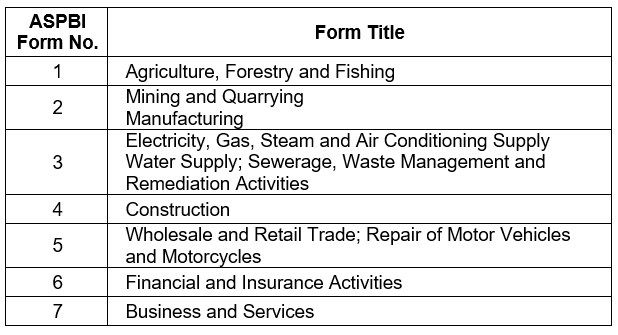
Each form of the survey questionnaire is available in three options. These are the following:
1. online questionnaire which can be accessed at https://aspbi.psa.gov.ph;
2. electronic copy of the questionnaire, either in portable document format (.pdf) or Excel (.xlsx) file format; and
3. printed copy of the self-administered questionnaire.
The sample establishment can choose from these options in recording the information for the data items in the survey questionnaire.
II.3. Data Items
The survey collected data on employment, revenue, expense, sales from e-commerce transactions, capital expenditure, book value of fixed tangible and intangible assets, average capacity utilization rate, and inventory.
II.4. Data Processing
To ensure quality of survey reports, several levels of validation following guidelines set were done during the processing phase of the survey operation.
Computer systems were also developed and used to facilitate the smooth conduct and monitoring of the survey operation. These were the Monitoring and Tracking System (MTS) and the Establishment Data Management System (EDMS) which are online systems. The MTS was used to monitor the real-time progress of the survey operation, which included distribution, collection, transmittal, manual processing, and data processing of questionnaires, among others. On the other hand, the EDMS was used in the processing of data and tabulation of survey results.
III. Methodology
III.1. Sampling Frame
The sampling frame for the 2021 ASPBI was extracted from the preliminary 2021 List of Establishments (LE) updated as of 24 January 2022. This frame was used to draw the sample establishments for the survey. The preliminary 2021 LE showed that there were 1,079,093 establishments that were in operation in the country of which 349,071 establishments comprised the sampling frame or the establishments that are within the scope and coverage of the 2021 ASPBI.
III.2. Sample Selection Procedure
The 2021 ASPBI uses a stratified systematic sampling design with 3-digit or 5-digit PSIC as the first stratification variable, depending on the section and total employment, which is classified into Micro, Small, Medium establishments (MSME), as the second stratification variable.
Stratified systematic sampling is a process of dividing the population into homogeneous groups, called strata, and then selecting independent samples in each stratum systematically. This method ensures that all important subgroups of the population are represented in the sample and increases the precision of “overall” survey estimates.
Domain
The geographic domain of the 2021 ASPBI is the region. The industry domain/stratum is a 3-digit or 5-digit industry classification, and the employment domain/stratum is the MSME classification.
Unit of Enumeration
The unit of enumeration for the 2021 ASPBI is the establishment.
III.3. Estimation Procedure
III.3.1. Weights Computation
Base Weight
The base weight is the inverse of the probability of selection. For the ASPBI, the base weight for each domain is given by:

Adjustment Factor
To take into account the non-responding sample establishments, the adjustment factor by region and industry section is as follows:
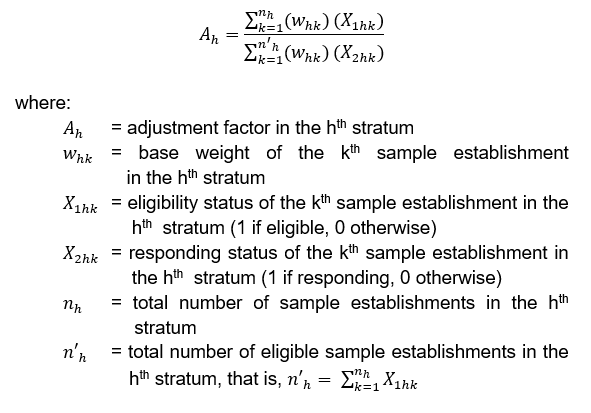
Final Weight
The final weight is the product of the base weight and adjustment factor. That is,

III.3.2. Estimation of Total
Total by Industry-Employment Stratum (h)
The estimator for the total of a characteristic in each industry-employment stratum (h) in a region (geographic domain) is given by:
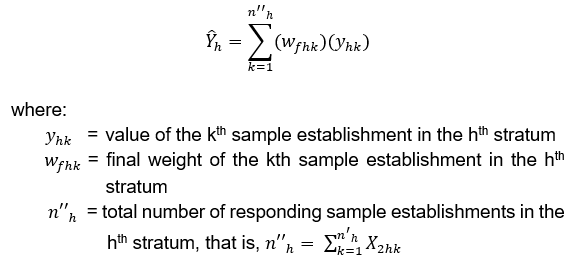
Total by Industry Stratum per Region
The estimator for the total of a characteristic in each industry stratum in a region is given by:

Total by Employment Stratum per Region
The estimator for the total of a characteristic in each employment stratum for the regional domain is given by:
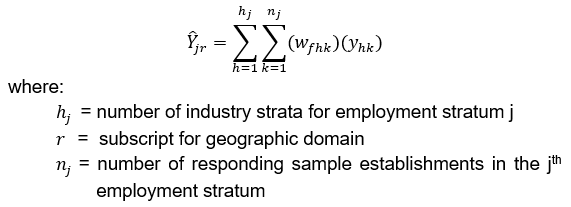
Total by Geographic Domain
The estimator for the total of a characteristic in each geographic domain is given by:
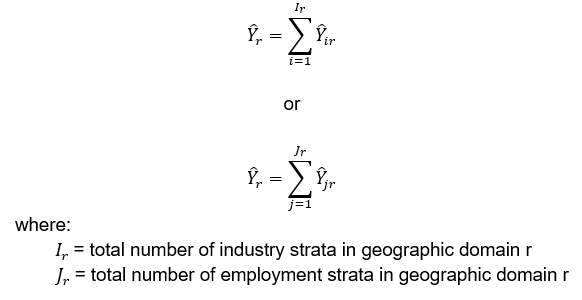
Total by Industry Stratum (National)
The estimator for the national total of a characteristic in each industry domain/stratum is given by:

Total by Employment Stratum (National)
The estimator for the national total of a characteristic in each employment domain/stratum is given by:

III.4. Response Rate
Response rate for all Mining and Quarrying section was 92.7 percent (427 out of 462 establishments). This included receipts of "good" questionnaires, partially accomplished questionnaires, and reports of closed, moved out, or out-of-scope establishments.
Of the total responses, 13 establishments or 3.0 percent responded online.
Reports of establishments which were found to be duplicate of another establishment, out-of-scope and out of business in 2021 were not included in the generation of statistical tables.
IV. Concepts and Definitions of Terms
An establishment is defined as an economic unit under a single ownership or control which engages in one or predominantly one kind of economic activity at a single fixed location.
An establishment is categorized by its economic organization, legal organization, industrial classification, employment size, and geographic location.
Economic Organization refers to the organizational structure or role of the establishment in the organization. An establishment may be a single establishment, branch, establishment, and main office with branches elsewhere, main office only, or an ancillary unit other than the main office.
Legal Organization refers to the legal form of the economic entity which owns the establishment. An establishment may be a single proprietorship, partnership, government corporation, stock corporation, non-stock corporation, or cooperative.
Industrial classification of an economic unit was determined by the activity from which it derives its major income or revenue. The 2009 PSIC which was approved for adoption by government agencies and instrumentalities through PSA Resolution No. 01 Series of 2017-158 signed on 14 February 2017, was utilized to classify economic units according to their economic activities.
Size of an establishment is determined by its total employment as of the time of visit during the latest Updating of the List of Establishments.
Total Employment (TE) refers to the total number of persons who work in or for the establishment. This includes paid employees, working owners, unpaid workers, and all employees who work full-time or part-time including seasonal workers. Also included are persons on short-term leave such as those on sick, vacation or annual leaves, and on strike.
Geographic Classification refers to the grouping of establishments by geographic area using the Philippine Standard Geographic Code (PSGC) classification. The PSGC contains the latest updates on the official number of regions, provinces, cities, municipalities, and barangays in the Philippines. The PSGC as of 31 December 2020 was used for the 2021 ASPBI.
Compensation is the sum of salaries and wages, separation/retirement/terminal pay, gratuities, and payments made by the employer on behalf of the employees such as contribution to SSS/GSIS, ECC, PhilHealth, Pag-ibig, etc.
Expense is the cost incurred by the establishment during the year whether paid or payable. This is treated on a consumed basis. Valuation is at purchaser price including taxes and other charges, net of rebates, returns, and allowances. Goods and services received by the establishment from other establishments of the same enterprise are valued as though purchased.
Paid employees are all persons working in the establishment and receiving pay, as well as those working away from the establishment paid by and under the control of the establishment. Included are all employees on sick leave, paid vacation, or holiday. Excluded are consultants, home workers, receiving pure commissions only, and workers on indefinite leave.
Revenue is the cash received and receivables for goods/products and by-products sold and services rendered. Valuation is at producer prices (ex-establishment) net of discounts and allowances, including duties and taxes but excluding subsidies.
Salaries and wages are payments in cash or in kind to all employees, prior to deductions for employee’s contributions to SSS/GSIS, withholding tax, etc. Included are total basic pay, overtime pay, and other benefits.
V. Dissemination of Results and Revision
The results of the 2021 ASPBI are disseminated through the posting of Special Releases and electronic publications on the PSA website, and final statistical tables in OpenStat. The updating or revisions on data were done upon finalizing the results of the 2021 ASPBI data.
This Special Release presents the results of the 2021 ASPBI for Mining and Quarrying establishments (Section B). Data are presented by industry group or 3-digit classification as classified under the 2009 PSIC.
VI. Citation
Philippine Statistics Authority. (September 2023). Technical Notes on the 2021 Annual Survey of Philippine Business and Industry (ASPBI).
https://psa.gov.ph/technical-notes/2021aspbi
VII. Contact Information
John Paul C. Sacop
(Supervising Statistical Specialist)
Officer-in-Charge, Industry Statistics Division
(632) 8376-2060
isd.staff@psa.gov.ph
For data request, you may contact the:
Knowledge Management and Communications Division
(632) 8462-6600 locals 820 and 823
info@psa.gov.ph
